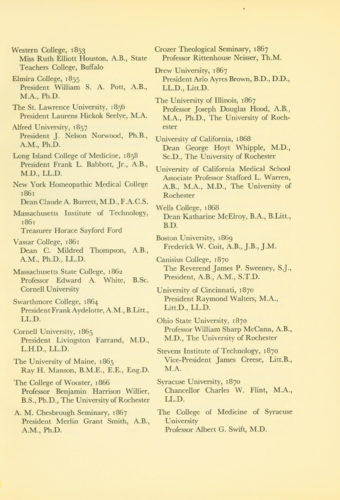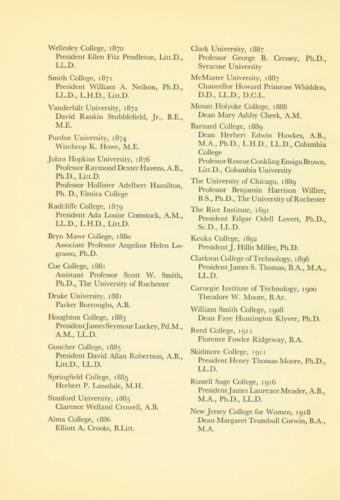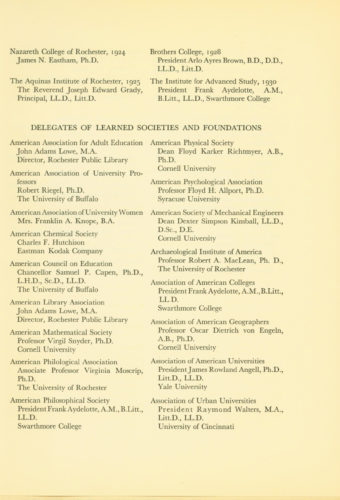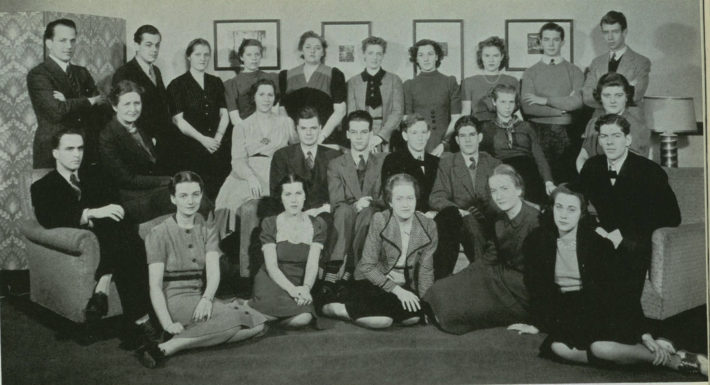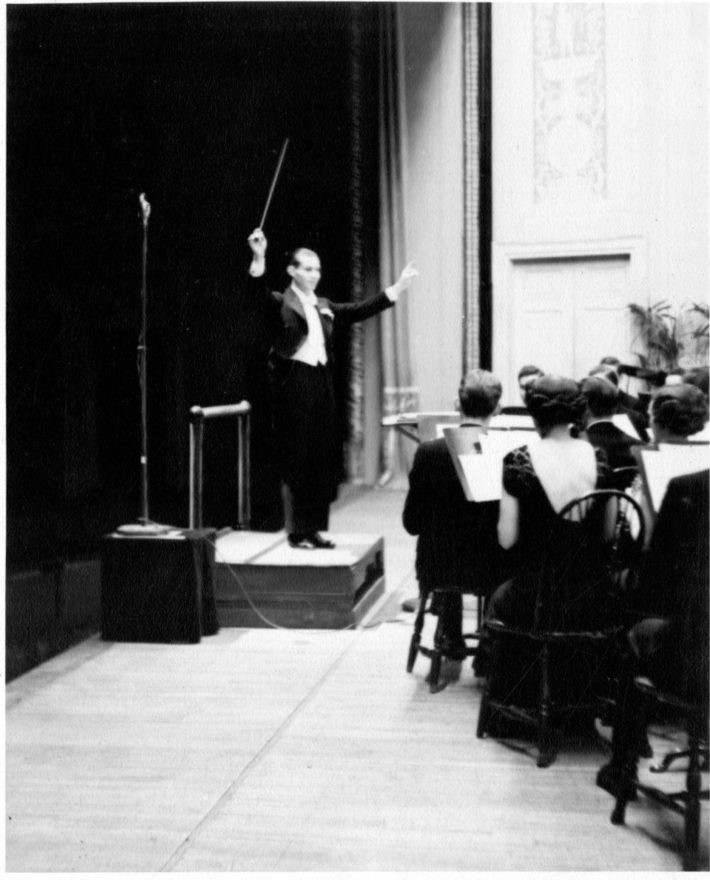Published on Nov 11th, 2024
1935: Inauguration of Dr. Alan Valentine to the Presidency of the University of Rochester
 Eighty-nine years ago this week, the Eastman Theater was the venue for the Inauguration of Dr. Alan Valentine as President of the University of Rochester. The Inauguration ceremonies on November 14th and 15th, 1935 confirmed once again the Eastman Theater’s prominence and significance as the University’s gathering place of choice since its opening in 1922. Alan Valentine (1901-1980), fourth President of the University of Rochester and also its youngest President to date, was the first to have been inaugurated in the Eastman Theater, which has been the venue for each President’s inauguration since then, the most recent having been President Mangelsdorf, the 11th President, in 2019.
Eighty-nine years ago this week, the Eastman Theater was the venue for the Inauguration of Dr. Alan Valentine as President of the University of Rochester. The Inauguration ceremonies on November 14th and 15th, 1935 confirmed once again the Eastman Theater’s prominence and significance as the University’s gathering place of choice since its opening in 1922. Alan Valentine (1901-1980), fourth President of the University of Rochester and also its youngest President to date, was the first to have been inaugurated in the Eastman Theater, which has been the venue for each President’s inauguration since then, the most recent having been President Mangelsdorf, the 11th President, in 2019.
Alan Valentine, an alumnus of Swarthmore and Pennsylvania and also a Rhodes scholar at Oxford, had previously served on the faculties of Swarthmore and Yale. A biographical sketch appears on the University Libraries website, and a substantive Appreciation of his life and career was published in the University of Rochester Library Bulletin (displayed here). His years as UR President were a time of profound transformation, on the local, national, and international fronts, locally, encompassing the later years of the Depression, the entirety of the Second World War, and the sweeping post-War societal changes. President Valentine eventually submitted his resignation in 1949 to answer a call to international service with the Economic Stabilization Agency under President Truman, an international aid and recovery effort (1950-53) more famously known as The Marshall Plan. The website of the George C. Marshall Foundation offers an account of the history of the Plan. Dr. Valentine’s specific position was as mission chief in The Hague, Netherlands. A further mark of distinction is that Dr. Valentine remains, to date, the only UR President to have been an Olympian. He was a member of the U.S. rugby team at the 1924 Olympic Games in Paris, where the Americans upset the heavily favored French team to win the gold medal.
The 1935 Inauguration was an extended sequence of events, with proceedings taking place on two successive days. The University published a separate order of ceremony for both days, each displayed here. Significantly, musical forces of the Eastman School of Music were active participants in the proceedings. Harold Osborn Smith[1] played the organ at the Thursday morning ceremony, offering the preslude, the processional, and the recessional. Between the Invocation and the several addresses, the Eastman School Symphony Orchestra performed Dvorák’s Carneval Overture, conducted by Paul White.[2] At the Friday morning ceremony, Robert Berentsen[3] was the organist, offering a prelude, the processional, and the recessional. The Eastman School of Music Symphony Orchestra again performed Dvorák’s overture Carneval. On the Thursday afternoon there were conferences taking place at the Men’s College, the Women’s College, and the School of Medicine and Dentistry. The Inauguration festivies concluded on the Friday evening with a concert in the Eastman Theater by the Eastman School of Music Symphony Orchestra under Dr. Howard Hanson’s direction.
► Order of ceremonies for November 14th, 1935, outlining the morning ceremony, the afternoon conferences, and the Friday evening concert.
► Order of ceremonies for November 15th, 1935, which also included the names of the many attending participants.
► An appreciation of the life and career of Alan Valentine (1901-1980), published in the University of Rochester Library Bulletin (1980).
The Benediction at the Thursday morning ceremony was given by Dr. Clarence A. Barbour, President of Brown University, who had previously served in Rochester. In 1890 Dr. Barbour had been appointed Pastor of Lake Avenue Baptist Church, and in 1915 he had been appointed President of Rochester Theological Seminary, to which he had been appointed in 1915. Dr. Barbour’s wife, Florence Newell Barbour, was a pianist and composer of some note.[4] The Barbours had left Rochester for the appointment to Brown University.
Apart from the published orders of ceremonies, the University also published a complete account of both days’ proceedings in book form that contained the full texts of the various addresses and statements that were delivered on both days, including President Valentine’s inaugural address, “The Aims of Education”. The book also included the text of an extended message delivered in real time by outgoing President, Dr. Rush Rhees, who was speaking remotely, as he and Mrs. Rhees had been unable to attend the Inauguration in person.
The Inauguration ceremonies and also the Friday evening concert were recorded by Eastman School personnel. Master discs are maintained in the Eastman School’s audio archive, and digital preservation tapes were formatted during preservation work several decades later. The Department of Rare Books, Special Collections, and Preservation at Rush Rhees Library holds a collection of souvenirs and press clippings dating from the Inauguration. In addition, Alan Valentine’s papers as President of the University reside in the University Archives.
Besides such high-profile occasions as presidential Inaugurations, the Eastman Theater has been the venue for annual Commencement ceremonies, for occasional Convocations for distinguished visitors (such as former Prime Minister of Israel Golda Meir in 1974), and for gatherings of civic purpose and of industrial purpose. The Eastman Theater continues to serve as a multi-purpose space—motion picture cinema, concert hall, opera house, auditorium, and convention hall, thereby fulfilling Mr. Eastman’s vision of an edifice serving the public for the enrichment of community life.
[1] Harold Osborn Smith, organist, vocal coach, and instructor of English, served on the ESM faculty 1924-54. He died in 1955.
[2] Dr. Paul White, Eastman alumnus, was a violinist, composer and conductor; he served on the ESM faculty 1928-65.
[3] Robert Berentsen, organist and instructor in the Eastman School’s program for film accompaniment organists, served 1923-30.
[4] On musical grounds I feel obliged to offer the following. Dr. Barbour’s wife, Florence Newell Barbour (1866-1949), a native of Providence, Rhode Island, was both composer and pianist. She enjoyed some success as a concert pianist, both as soloist with orchestras and as solo recitalist, and also performing her own compositions in radio broadcasts. Locally, Mrs. Barbour gave numerous performances under the auspices of the Tuesday Musicale, a Rochester concert society (1891-1926). Given the morés of the time, she was frequently identified on concert programs as “Mrs. C. A. Barbour” in relation to her husband. Besides performing, Mrs. Barbour composed prolifically for the piano and also for voice, setting texts by a variety of poets. Her principal publisher was Arthur P. Schmidt (Boston); in addition, some of her works were published by Carl Fischer, M. Witmark, and Luckhardt and Belder, all of New York City. In Rochester, her music was published by Gibbons and Stone.










